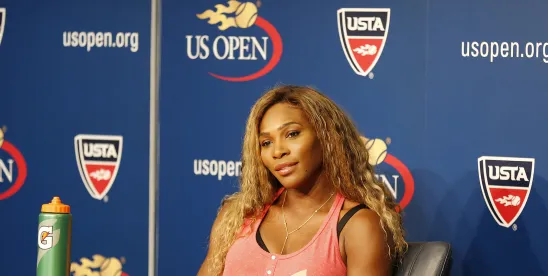On August 29, 2024, the U.S. Food and Drug Administration (FDA) Office of Prescription Drug Promotion (OPDP) issued an untitled letter to AbbVie, Inc. (AbbVie) regarding a promotional, direct-to-consumer (DTC) television advertisement (TV ad) for UBRELVY® (ubrogepant) tablets, for oral use (Ubrelvy).[1] Ubrelvy is indicated for the acute treatment of migraine with or without aura in adults.[2] FDA concluded that the TV ad – which featured tennis star Serena Williams – misleadingly suggested that Ubrelvy provides greater benefits than has been demonstrated and was therefore misbranded under FDA regulations.
The first read of this letter—especially the last sentence on the first page, plus citations—might lead one to believe that FDA is serving-up a new tactic in enforcement, picking on AbbVie for using a public figure for advertising. But FDA’s argument is much more pedestrian—“fast” or “quickly” is less than “two hours,” and using conditional words like “can” might help if studies showed that more than one dose is required to relieve symptoms. Moreover, while redacted, it appears this issue arose in another context where advisory comments were provided to the same effect. We will explain FDA’s approach—as well as the flaws in that approach—below.
Promotional Claims at Issue
In this letter, FDA was primarily concerned with the misleading impression created by the following presentation and claims:
- In frames one to four, Serena Williams is shown experiencing symptoms of migraine pain and photophobia while preparing to appear on a talk show. The next frame shows the Ubrelvy logo in the backstage hallway along with a blue lit path. Frames six to seven then show Serena Williams walking down the blue lit path, no longer exhibiting migraine symptoms, and holding up a single 100 mg dose packet of Ubrelvy.
- Serena William’s voice over (VO) claim “One dose works fast to eliminate migraine pain” with the accompanying SUPER “UBRELVY QUICKLY ELIMINATES MIGRAINE PAIN.” (emphasis added).
According to FDA, the combination of this “compelling before-and-after presentation” with the VO and SUPER claims “misleadingly suggests that Ubrelvy eliminates migraine pain and symptoms more quickly than was demonstrated in the clinical trials.” In particular, FDA reasoned that the claims were not supported by the two clinical trials included in the CLINICAL STUDIES section of the drug’s Prescribing Information (PI). According to FDA, the endpoints for these studies measured “effect of pain freedom at two hours post-dose” and “effect on most bothersome symptom (MBS) . . . freedom at two hours post-dose.” (emphasis added). FDA further highlighted the results from each trial:
- “In Study 1, 19.2%, 21.2%, and 11.8% of patients achieved pain freedom at 2 hours in the Ubrelvy 50 mg, Ubrelvy 100 mg, and placebo groups, respectively (7.4%-9.4% difference from placebo); 38.6%, 37.7%, and 27.8% of patients achieved freedom from MBS in the Ubrelvy 50 mg, Ubrelvy 100 mg, and placebo groups, respectively (9.9%-10.8% difference from placebo).”
- “In Study 2, 21.8% and 14.3% of patients achieved pain freedom at 2 hours in the Ubrelvy 50 mg and placebo groups, respectively (7.5% difference from placebo); and 38.9% and 27.4% of patients achieved freedom from MBS in the Ubrelvy 50 mg and placebo groups, respectively (11.5% difference from placebo).”
Although not expressly stated, FDA’s conclusion and reasoning strongly suggests that the agency did not view a two-hour onset of action to be “fast” or “quick” and/or that an insufficient percentage of subjects were shown to have achieved pain or MBS freedom by the two-hour mark.
FDA also found that the TV ad “misleadingly suggests that all patients who take Ubrelvy can expect their migraine pain to be eliminated after a single dose.” In so doing, FDA again pointed to the CLINICAL STUDIES section of the PI and stated that “approximately 19% to 22% of patients achieved pain freedom at two-hours after receiving one dose” of the drug whereas “approximately 78% to 81% of patients did not achieve pain freedom after receiving one dose of Ubrelvy.” In addition to these findings, FDA also noted that the DOSAGE AND ADMINISTRATION section of the PI states that patients may take a second dose of the drug “at least 2 hours after the initial dose.”
Additionally, although FDA recognized the inclusion of the disclaimer “Some people had pain freedom within 2 hours” in small text on the SUPER, FDA concluded that this disclaimer was insufficient to correct the misleading impression created by both the onset of action and dose claims.
Takeaways
The end of the summer has shown an uptick in untitled letters, perhaps indicating that OPDP may be more active in the latter half of 2024—or maybe OPDP will take another long break like it did in 2022 to 2023. Importantly, however, this letter underscores several key trends—some painfully obvious and some more nuanced—that we continue to see in OPDP letters.
Of course, the fact that the TV Ad targeted a DTC audience played a key role in FDA’s decision to take enforcement action. Such advertisements have traditionally received closer scrutiny from the agency, and has been a recent point of focus for advertising-related guidances and rulemaking.[3]
Moreover, the inclusion of a celebrity endorser clearly played a contributing role in issuing this letter. This is the second letter this year where FDA has targeted a DTC-focused advertisement featuring a celebrity.[4] In the Ubrelvy letter, FDA explained that “the use of a celebrity athlete . . . amplifies the misleading representations and suggestions made and increases the potential for audiences to find the misleading promotional communication more believable due to the perceived credibility of the source.” In support of this assertion, the agency cited to various publications, at least one of which has appeared before in FDA notices.[5] Over the past few years, OPDP has conducted research on the impact of various endorser types, including celebrities, in DTC pharmaceutical promotion.[6] Although this research is pending peer review and publication,[7] FDA’s lengthy citation in the Ubrelvy letter may indicate a focus for future enforcement and guidance once OPDP’s study is published.
Digging deeper and looking at the content of the ad itself, this letter is another instance this year in which the CFL guidance[8] has played a role in FDA’s decision to take action. This letter is a classic example of FDA’s perceived failure to provide appropriate context relating to data or information included in the FDA-required labeling.[9] As described above, according to FDA, the DTC audience viewing the TV Ad would misconstrue the overall presentation to mean that Ubrelvy worked faster than the two-hour time period described in the PI and that it would do so with only one dose.
To be sure, the TV Ad included language in the SUPER stating “Some people had pain freedom within 2 hours”; however, FDA was apparently dissatisfied with this language. One reason may be that FDA found the disclaimer to be too general. As discussed in the CFL guidance, contextual information “should be presented in a clear and prominent way” and, in evaluating whether disclosures are satisfactory, FDA considers not only the “location, font size, contrast, and white space” but also “whether it is presented in a way that is likely to be read and understood by those receiving the communication.”[10] Accordingly, FDA may have felt that the phrasing “some people” was too vague (e.g., is “some” most, or just a fraction?) and this ambiguity – combined with the fact that the statement appeared in tiny lettering, below a gigantic “quickly eliminates” presentation – amplified potential confusion for consumers.
Adding to this, FDA was also concerned that the audience would be unaware of the passage of time between taking the medication and freedom from migraine pain and symptoms.[11] After all, the TV Ad seemingly does not include any sort of obvious time-related element such as a clock, wristwatch, sunrise and sunset, etc.
However, upon closer inspection, FDA’s reasoning here may be a bit suspect. In particular, the core presentation in the TV Ad is Serena Williams before and after receiving hair and makeup services in preparation for a talk show. While this may not be a traditional depiction of the passage of time, even a quick Google search shows that full “glam” (i.e., hair and makeup) services may take anywhere from 90 minutes to a couple of hours. Perhaps this is another judgment call from the agency that there is too great a risk that DTC audiences will not draw this connection. However, this line of reasoning also opens additional questions of what narratives would be acceptable to FDA to depict the passage of time.
Aside from this, FDA also noted that the agency had previously provided advisory comments for similar promotional claims for Ubrelvy. According to FDA, these advisory comments were provided to the previous application holder for Ubrelvy. Although the majority of FDA’s comments concerning “Prior communications” were redacted in the letter, FDA’s decision to include this passage may suggest that the agency believes that the onus is on manufacturers to obtain information concerning previous FDA-correspondence when purchasing and rebranding a pharmaceutical product.
All in all, while simple on its face, this letter provides some much needed guidance regarding FDA’s priorities. As always, manufacturers should continue to ensure that their promotional communications align with FDA-required labeling, provide appropriate context where needed, and do not expressly state or imply greater efficacy than shown for their drug. And, moving forward, stakeholders should keep an eye on additional enforcement or potential guidances concerning DTC audiences and celebrity endorsers, especially in light of OPDP’s pending research and upcoming compliance date for the DTC rule.
FOOTNOTES
[1] Promotional Material available here: Ubrelvy Promotional Material (fda.gov).
[2] Ubrelvy carries a Limitation of Use, stating that it is not indicated for the preventative treatment of migraine.
[3] See, e.g., Direct-to-Consumer Prescription Drug Advertisements: Presentation of the Major Statement in a Clear, Conspicuous, and Neutral Manner in Advertisements in Television and Radio Format, 88 Fed. Reg. 80958 (Nov. 21, 2023); Presenting Quantitative Efficacy and Risk Information in Direct-to-Consumer (DTC) Promotional Labeling and Advertisements Guidance (Dec. 2023).
[5] See, e.g., Agency Information Collection Activities; Submission for Office of Management and Budget Review; Comment Request; Endorser Status and Actual Use in Direct-to-Consumer Television Ads, 88 Fed. Reg. 26316, 26318 (Apr. 28, 2023) (citing Bhutada, N.S. and B.L. Rollins, ‘‘Disease-Specific Direct-to-Consumer Advertising of Pharmaceuticals: An Examination of Endorser Type and Gender Effects on Consumers’ Attitudes and Behaviors,’’ Research in Social and Administrative Pharmacy, Vol. 11, Issue 6, pp. 891–900, 2015).
[6] See id.
[7] See Research Pending Peer Review and Publication | Office of Prescription Drug Promotion (OPDP) Research (noting that OPDP’s “Endorser Status and Explicitness of Payment in Direct-to-Consumer Promotion” study is completed and pending peer review and publication).
[8] “Medical Product Communications That Are Consistent With the FDA-Required Labeling, Questions and Answers” (CFL Guidance) available here: *Medical Product Communications That Are Consistent With the FDA-Required Labeling — Questions and Answers Guidance for Industry.
[9] See id. at 15.
[10] See id. at 14, n. 25 & 15.
[11] To be sure, FDA noted that time-related elements were included in the original storyboard submitted to FDA on the FDA Form 2253. In particular, FDA explained that the original storyboard more clearly indicated the passage of time (e.g., opening by showing Serena Williams in the afternoon, and then later showing Serena Williams doing a final check in the mirror in the evening before heading out to the talk show), however, “the audience . . . is not privy to this information.” Ubrelvy Letter, at 4 n. 6.




 />i
/>i

